Landscape and Biodiversity projects
Find out what projects the South Downs National Park Authority is currently supporting to improve biodiversity and enhance habitats for wildlife within the National Park.
Click on the project title below for more details about Landscape and Biodiversity projects we are currently supporting, who we are working with to deliver the projects and how these projects meet the outcomes of our Partnership Management Plan (PMP). You can also see where in the National Park these Landscape and Biodiversity projects are on our interactive map (indicated in green).
For case studies and details of past projects, click here.
-
- Bringing back the Elms
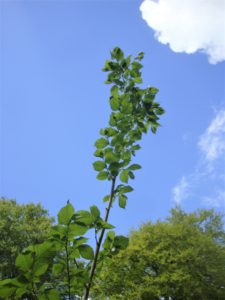 Elm was once one of the most common trees in the English countryside, and a major landscape component of the South Downs’ landscape historically. Unfortunately, elm trees have been decimated by Dutch Elm Disease.
Elm was once one of the most common trees in the English countryside, and a major landscape component of the South Downs’ landscape historically. Unfortunately, elm trees have been decimated by Dutch Elm Disease.In addition to its landscape value, elm trees are also the main food plant for the White Letter Hairstreak Butterfly (UK BAP species, GB red list ‘endangered’, and S.41 NERC species).
This project is about the conservation of elm in the South Downs Landscape, and providing more options for the ‘Right Tree in the Right Place’ that are resilient for the future. It is also about engaging communities in their local trees and the wider environment.
By planting more DED resistant elms, we will be able to provide biodiversity, economic and people benefits- the very pillars of sustainability.
Partners: Butterfly Conservation, English Woodlands, Seaford Tree Wardens, Petersfield Society.
PMP outcomes: 1.1 (Protect Landscape Character), 1.2 (Create Green Infrastructure), 1.3 (Target New Payments), 2.2 (Improve Trees and Woodland) and 3.2. (Manage priority and invasive species).
- Changing Chalk
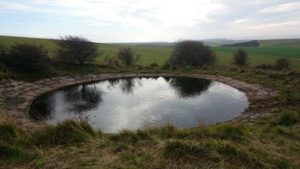 Changing Chalk is a partnership of organisations working together for a sustainable future for the South Downs. Led by the National Trust, and funded by the National Lottery Heritage Fund, the partnership will connect nature, people and heritage by restoring lost landscapes and habitats, bringing history to life and offering new experiences in the outdoors. Working with the communities of Brighton & Hove, Eastbourne and Lewes we aim to protect and restore the Downs landscape for people to enjoy for health and wellbeing, for nature’s recovery and for climate resilience.
Changing Chalk is a partnership of organisations working together for a sustainable future for the South Downs. Led by the National Trust, and funded by the National Lottery Heritage Fund, the partnership will connect nature, people and heritage by restoring lost landscapes and habitats, bringing history to life and offering new experiences in the outdoors. Working with the communities of Brighton & Hove, Eastbourne and Lewes we aim to protect and restore the Downs landscape for people to enjoy for health and wellbeing, for nature’s recovery and for climate resilience.The SDNPA is delivering 2 of the 18 projects of Changing Chalk:
- Supporting conservation grazing at a landscape scale, through the establishment of multiple grazing hubs.
- Restoring key dew ponds in the Eastern Downs to provide water for grazing animals.
You can find out more about the project on the Changing Chalk website.
Partners: National Trust, Brighton and Hove City Council, Brighton and Hove Food Partnership, The Living Coast Biosphere, Natural England, Lewes Railway Land Trust, Sussex Wildlife Trust, Buglife, Lewes and Eastbourne Councils.
PMP outcomes: 1.1 (Protect Landscape Character), 1.2 (Create Green Infrastructure), 3.1 (Join Up Habitats), 3.2 (Managing Priority and Invasive Species).
- Cut and Collect
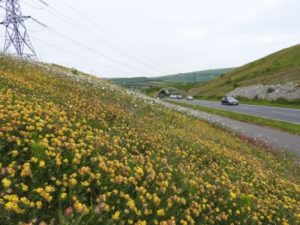 This project will enhance road verges, provide more areas of species rich grassland and improve habitats for insects and pollinators.
This project will enhance road verges, provide more areas of species rich grassland and improve habitats for insects and pollinators.Partners: West Sussex highways Authority & Sussex Wildlife Trust
PMP outcomes: 1.1 (Protect Landscape Character), 1.2 (Create Green Infrastructure), 3.1 (Join Up Habitats).
- Farm Carbon Project
In the UK, it is estimated that agriculture contributes 10% to total annual greenhouse gas emissions, namely nitrous oxide, methane and carbon dioxide. As the climate emergency intensifies, the SDNPA has set a target for the SDNP to be ‘Net Zero with Nature’ by 2040, alongside the NFU’s Net-Zero in British farming by 2040 and the Government’s target for Net-Zero by 2050.
Farming can both emit and sequester carbon, with many factors such as the farming system and land type influencing the overall picture. Approximately 75% of the SDNP area is designated as farmland, and with the launch of ELM in 2024 providing ‘public payments for public goods’, it is clear that the agricultural sector can play a significant role in tackling this issue.
As the SDNPA develops its Climate Change Action Plan working towards its ‘Net- Zero with Nature’ by 2040 target, the actions taken by farmers and landowners will be key its achievement. This project will enable data gathering and the development of practical actions between farmers and specialists to inform this process, ensure co-design and set out actions that are practical and realistic.
Partners: Stephen Woodley Crop Services; South West Farm Consultants; Farm Carbon Toolkit; Farmer Clusters
PMP outcomes: 2 (Increasing Resilience); 2.1 (Improve Soil and Water)
- Floodplain Meadows in the Rother Valley
This three year project will trial restoration of two floodplain hay meadows in the Rother Valley. In addition, it will include a local floodplain meadows history engagement events and oral histories to build a picture of the past to help inform the future. Outputs will include a repository of local knowledge, guidance and support around floodplain meadows restoration in the Rother Valley and a greater depth of understanding of the roles and importance of floodplain meadows in the historic Rother Valley landscape.
The project will be run and managed by a project officer for the Arun and Rother Rivers Trust.
The aims of the project:
- To trial hay meadow restoration on two floodplain sites on the River Rother, West Sussex in order to inform, guide and expand future restoration efforts.
- Working with partners to maximise Ecosystem Service provision.
- Provide further land management approaches to reduce sediment transport.
- Create a repository of knowledge and guidance for others to aid with floodplain meadow restoration.
- To build a picture of the history of floodplain meadows in the Rother Valley through engagement with locals and oral history interviews with past land managers and workers.
Understand how floodplain meadows could be utilised to build greater catchment resilience to sediment and other services.
Partners: Arun and Rother Rivers Trust
PMP outcomes: 1.1 (Protect Landscape Character), 1.2 (Create Green Infrastructure), 1.3 (Target New Payments), 2.1 (Improve Soil and Water), 2.2 (Improve Trees and Woodland), 3.1 (Join Up Habitats), 3.2 (Managing Priority and Invasive Species), 4.1 (Conserve Heritage), 4.2 (Promote Contemporary Arts and Crafts).
- Grandfather’s Bottom, Butser Hill
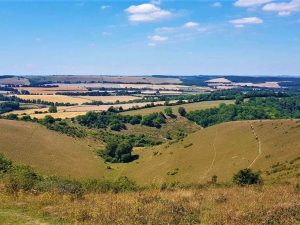 The project will protect and enhance 1.6ha chalk heath and restore 7ha chalk grassland at Grandfather Bottom by reducing scrub encroachment and installing infrastructure to support improved grazing. scrub removal would widen the foreground views and enable the recreation of chalk downland with its myriad of grassland species, butterflies, insects and birds to re -establish. This would reveal the drama of the topography and reduce the visual interest in the skyline and line of pylons. Scrub clearance at Hilhampton Down will enable the creation of a new route through the hillside, creating a new vista and aspect to the downland and an interesting alternative to the SDW track.
The project will protect and enhance 1.6ha chalk heath and restore 7ha chalk grassland at Grandfather Bottom by reducing scrub encroachment and installing infrastructure to support improved grazing. scrub removal would widen the foreground views and enable the recreation of chalk downland with its myriad of grassland species, butterflies, insects and birds to re -establish. This would reveal the drama of the topography and reduce the visual interest in the skyline and line of pylons. Scrub clearance at Hilhampton Down will enable the creation of a new route through the hillside, creating a new vista and aspect to the downland and an interesting alternative to the SDW track.The visitor experience will be improved through new signage and car parking improvements. Redesigning the car park will make it more in keeping with the downland landscape, ensure clearer routes for pedestrians and provide tree cover to frame views of the chalk downland. areas to bring the car park ‘into the landscape’ and allow the experience of Butser Hill to begin as you get out of the car. Clear routes would direct visitors away from views of the overhead lines just over 1km to the west and towards the NNR. New interpretation signage which will enable visitors to have a better understanding of the natural and cultural heritage of Butser Hill.
This project is supported by National Grid, through the Landscape Enhancement Initiative, and the Tesco Community Grants scheme.
Partners: Hampshire County Council
PMP outcomes: 1.2 (Create Green Infrastructure),3.1 (Join Up Habitats), 4.1 (Conserve Heritage), 5.2 (Improve accessibility), and 6 (Lifelong Learning).
- Greenspaces
Parks and open spaces play an important role in nature recovery, health and well being, and green infrastructure in urban, coastal and rural areas. Green spaces should be designed and managed to maximise their value for nature, natural services and for people. The project provides an opportunity to progress the Partnership Management Plan (PMP) and People and Nature Network (PANN), to provide a Sussex wide toolkit to improve health outcomes and nature recovery in public open greenspace.
The project is funded by the SDNPA and the Public Health Team at East Sussex County Council. The work will take place under three strands:
The initial stage of the project is split into three strands:
- Strand 1: Ecological and natural capital assessment
- Strand 2: Social engagement methodology for identifying social, cultural and health benefits
- Strand 3: Health Audits for greenspaces in three parish/town council areas in Wealden District, East Sussex
The partners will work with three consultants to develop and test methodologies in Adur & Worthing and Wealden. This work will link to project learning in the wider SDNP area.
A final stage of the project will bring the learning from the three strands together in one toolkit. The toolkit will be aimed at individuals, community groups and local authority staff and promoted across Sussex by the Sussex Local Nature Partnership.
Partners: East Sussex County Council, Sussex Local Nature Partnership, Adur and Worthing Borough Council, Wealden District CouncilPMP outcomes: 1.2 (Create Green Infrastructure), 3.1 (Join Up Habitats), 7.1 (Improve Health and Wellbeing), 8.1 (Increase Volunteering), Outcome 9.2 (Support Vibrant Communities).
- Hampshire Hedgerows
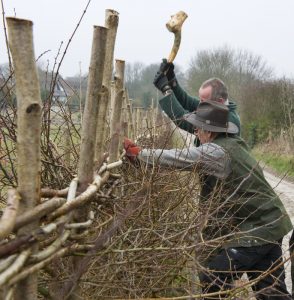 The Hampshire Hedgerows project will work collaboratively with landowners through Selborne & Winchester Downs Farmer-led Clusters to restore 20km+ hedgerows within, and immediately adjoining, the South Downs National Park (SDNP) protected landscape. The project will increase connectivity between habitats (e.g. woodland to pond) and benefit target species such as harvest mouse, dormouse, yellowhammer and brown hairstreak butterfly, as well as providing bat foraging routes.
The Hampshire Hedgerows project will work collaboratively with landowners through Selborne & Winchester Downs Farmer-led Clusters to restore 20km+ hedgerows within, and immediately adjoining, the South Downs National Park (SDNP) protected landscape. The project will increase connectivity between habitats (e.g. woodland to pond) and benefit target species such as harvest mouse, dormouse, yellowhammer and brown hairstreak butterfly, as well as providing bat foraging routes.The project will ensure the traditional skills of hedge laying will be reinforced for farm workers and hedge laying training for young people will also be provided as part of the project. The intensification of farming has had far-reaching impacts for wildlife, with the removal of hedgerows to create larger fields & accommodate larger machinery among the most visible changes to our countryside since WW2. With reduced management has come a loss of skills – the number of people trained in hedge laying, a once widespread rural skill, has declined dramatically – so it is vital that landowners have the opportunity to reskill in this area, & that more young people are given the chance to try hedge laying & consider pursuing a career in countryside management.
We are grateful for funding from the SLP Project and the government’s Green Recovery Challenge Fund. The fund is being delivered by The National Lottery Heritage Fund in partnership with Natural England and the Environment Agency.
Partners: Selborne Landscape Partnership & Winchester Downs Farm Cluster
PMP outcomes: 1.1 (Protect Landscape Character), 1.2 (Create Green Infrastructure), 2 (Increasing Resilience).
- Heathlands Reunited Wealden Heath SAMM
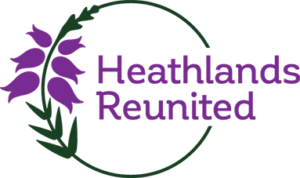 Bigger, better, heathlands that people know about, care about, and use responsibly and sustainably.”
Bigger, better, heathlands that people know about, care about, and use responsibly and sustainably.”The “Heathlands Reunited Wealden Heath SAMM” project brings together 12 likeminded organisations to help protect and enhance the Shortheath Common Special Area of Conservation (SAC) and the Wealden Heath Special Protection Area (SPA) which sit in, and are on the boundary of, the South Downs National Park. The SPA sites covered by the project are:
- Bramshott Common
- Broxhead Common
- Kingsley Common
- Longmoor Inclosure
- Ludshott Common
- Woolmer Forest
- Shortheath Common
As well as practical conservation work, the project’s key aim is to promote heathland that people know about, care about, and use responsibly and sustainably. Through a team of Engagement Rangers, activities such as guided walks, pop-ups and family activities will inform, engage and involve local communities to use their heathland in a responsible way and protect them for future generations.
The project is being funded by East Hampshire District Council (EHDC) and Whitehill Town Council (WTC) through Section 106 (S106) developer contributions.
You can find out more about the project here.
Partners: Amphibian and Reptile Conservation, Deadwater Valley Trust, Defence Estates, East Hampshire District Council, Forestry Commission, Hampshire & Isle of Wight Wildlife Trust, Hampshire County Council, The Land Trust, Whitehill and Bordon Community Trust and Whitehill Town Council.
PMP outcomes: 3.1 (Join Up Habitats)
- Lullington Heath
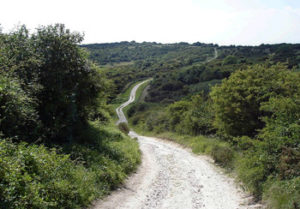 This project is for a financial contribution to carry out habitat restoration work in winter 2020/21 – 2022/23 and is a long term restoration plan. SDNPA will be an important partner to Natural England who manage the NNR in executing this restoration. The main aims will be to clear large areas of invasive gorse from the site and to ensure that good grazing management is in place to regenerate the chalk heath species.
This project is for a financial contribution to carry out habitat restoration work in winter 2020/21 – 2022/23 and is a long term restoration plan. SDNPA will be an important partner to Natural England who manage the NNR in executing this restoration. The main aims will be to clear large areas of invasive gorse from the site and to ensure that good grazing management is in place to regenerate the chalk heath species.You can find a leaflet with walking routes for Lullington Heath here.
Partners: Natural England, South East Water, Forestry England, and a neighbouring farmer who grazes site.
PMP outcomes: Outcome 2 (Increasing Resilience) and Outcome 3 (Habitats and Species).
- On Course to Flail
This project will provide the tools, knowledge and inspiration for better management of chalk grassland on golf courses in the Eastern Downs (starting with 1 golf course).
Partners: Pyecombe Golf Club
PMP outcomes: 2.1 (Improve Soil and Water), 3.1 (Join Up Habitats), 3.2 (Managing Priority and Invasive Species).
- Rampion Monitoring
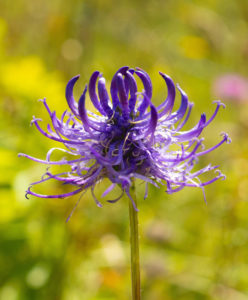 The Rampion 1 Scheme consisted of 116 offshore wind turbines being constructed by E.ON 14km off the coast at Brighton and its associated 30m wide cable construction route which passed through 14km of the National Park. The wind farm started generating power in November 2017. All of the cable has now been laid through the Park and the landscape has been reinstated. As part of the planning consent E.ON committed to a 10 year monitoring period following reinstatement, including financial support to the SDNPA for a monitoring officer during this 10 year period to oversee the discharge of consents within the onshore construction area of the National Park. The SDNPA monitoring officer for the Rampion 1 scheme was responsible for monitoring and ensuring all reinstatement is suitably delivered as well as overseeing the S106 mitigation fund for SDNPA projects within the Rampion area.
The Rampion 1 Scheme consisted of 116 offshore wind turbines being constructed by E.ON 14km off the coast at Brighton and its associated 30m wide cable construction route which passed through 14km of the National Park. The wind farm started generating power in November 2017. All of the cable has now been laid through the Park and the landscape has been reinstated. As part of the planning consent E.ON committed to a 10 year monitoring period following reinstatement, including financial support to the SDNPA for a monitoring officer during this 10 year period to oversee the discharge of consents within the onshore construction area of the National Park. The SDNPA monitoring officer for the Rampion 1 scheme was responsible for monitoring and ensuring all reinstatement is suitably delivered as well as overseeing the S106 mitigation fund for SDNPA projects within the Rampion area.Partners: E.ON
PMP outcomes: 4.1 (Conserve Heritage).
- The Aquifer Partnership (TAP)
 The Aquifer Partnership builds on the successful foundations of ChaMP as an exemplar collaborative approach to addressing the issue of groundwater pollution in the Brighton Chalk Block. The programme is designed to achieve greater impact together than each partner could achieve individually, bringing together significant technical expertise to create added value.
The Aquifer Partnership builds on the successful foundations of ChaMP as an exemplar collaborative approach to addressing the issue of groundwater pollution in the Brighton Chalk Block. The programme is designed to achieve greater impact together than each partner could achieve individually, bringing together significant technical expertise to create added value.You can find out more details about the project on the TAP Website.
Partners: Brighton & Hove City Council, Environment Agency, Southern Water, University of Brighton, The Living Coast (Brighton & Lewes Downs UNESCO Biosphere) .
PMP outcomes: 1.1 (Protect Landscape Character), 1.2 (Create Green Infrastructure), 2.1 (Improve Soil and Water).
- Bringing back the Elms
